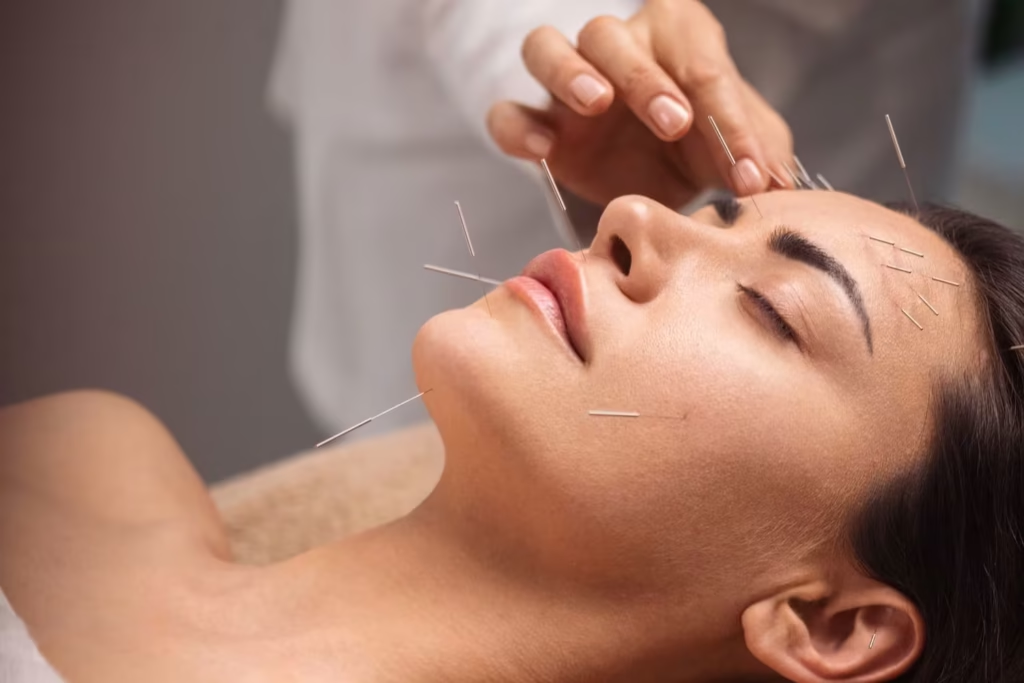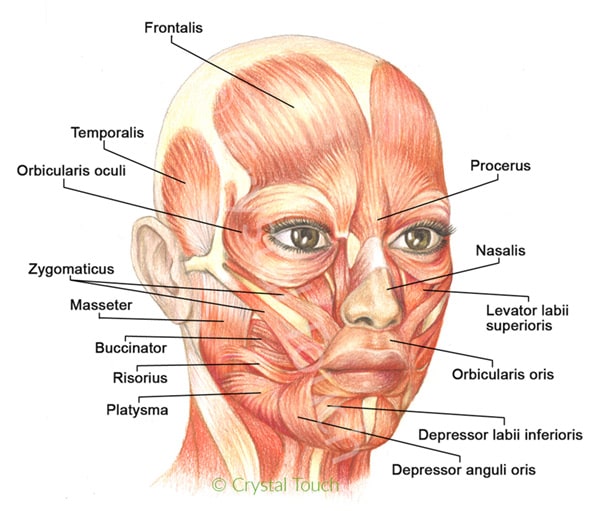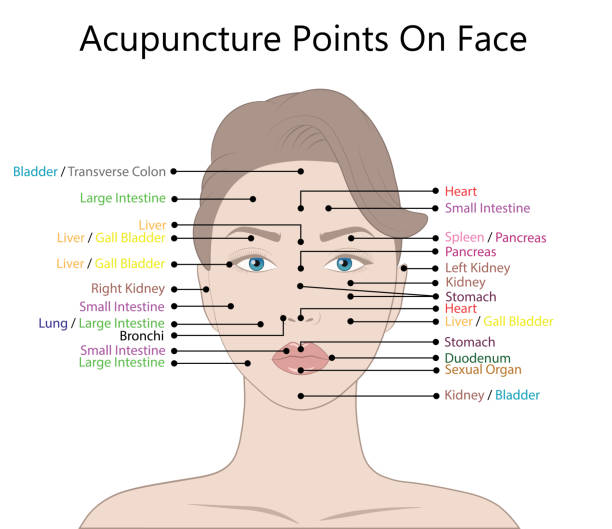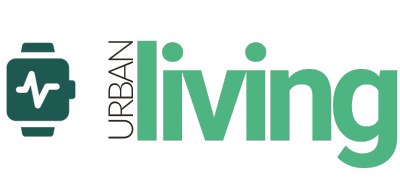Facial acupuncture, also known as cosmetic acupuncture, is a specialized branch of Traditional Chinese Medicine (TCM) that has gained significant popularity in Singapore and across Asia.

This holistic beauty treatment involves the gentle insertion of ultra-fine needles into specific points on the face and body to improve skin appearance while promoting overall health and well-being.
Unlike invasive surgical procedures such as Botox or fillers, facial acupuncture offers a natural alternative to achieve a lifted, firmer appearance without the associated risks.
The treatment’s origins trace back to ancient China, but it has experienced a revival in recent years, with celebrities like Kim Kardashian and Gwyneth Paltrow publicly endorsing its benefits.
Read more: Acupuncture in Singapore: Types, Benefits
The Science Behind Facial Acupuncture

TCM Principles and Modern Understanding
In Traditional Chinese Medicine, facial acupuncture operates on the principle that vital energy (Qi) flows through specific meridians or pathways throughout the body.
When these energy channels become blocked, various health issues can manifest, including skin problems.
By inserting needles into precise acupuncture points, practitioners aim to rebalance Qi flow, addressing both external appearance and internal imbalances.
From a modern physiological perspective, facial acupuncture creates positive microtraumas—tiny, controlled injuries that trigger the body’s natural healing response.
This might help: Best TCM Clinic in Singapore (Sort by Reviews)
These microtraumas stimulate several beneficial processes that contribute to facial rejuvenation and improved skin health.
Enhanced circulation occurs as needle insertion boosts blood flow to facial tissues, delivering essential nutrients and oxygen while facilitating the removal of waste products and toxins.
Collagen production is activated when the microtraumas stimulate fibroblast cells, which produce collagen and elastin—proteins crucial for maintaining skin structure, firmness, and elasticity.
Muscle toning results from strategic needle placement that helps tone and firm facial muscles, combating sagging and creating a natural lifting effect.
Systemic balance is achieved as facial acupuncture often incorporates body points to address underlying conditions affecting skin health, such as digestive issues or stress, creating comprehensive wellness support.
More information: Best TCM Clinic in JB for Singaporeans
Comprehensive Benefits of Facial Acupuncture
Facial acupuncture offers numerous benefits beyond superficial appearance improvements, truly embodying the TCM approach of treating both symptoms and root causes:
Skin Rejuvenation Benefits
- Reduction of Fine Lines and Wrinkles: Stimulates collagen and elastin production, naturally filling in wrinkles for smoother skin
- Improved Muscle Tone: Creates a natural face-lift effect by toning and tightening facial muscles
- Enhanced Skin Complexion: Increases blood circulation, resulting in a natural glow and more even skin tone
- Balanced Skin Texture: Helps reduce hyperpigmentation, dark spots, and rough patches
- Lightening of Age Spots and Scars: Promotes cellular regeneration to diminish discoloration
- Minimized Acne and Inflammation: Reduces redness and swelling associated with acne and other skin conditions
- Reduced Puffiness: Decreases water retention and facial bloating, particularly around the eyes
- Tightened Pores: Improves overall skin texture and appearance
You might like: Cupping Therapy in Singapore: Types, Benefits
Holistic Health Benefits
Facial acupuncture provides numerous holistic health benefits beyond cosmetic improvements.
Stress reduction occurs as the treatment activates the body’s relaxation response and releases endorphins, promoting overall wellbeing.
Many clients report improved sleep quality following treatment, which contributes to better skin regeneration and overall health.
The treatment addresses balanced internal systems by targeting underlying conditions like digestive issues that can manifest as skin problems.
Enhanced overall vitality is achieved by improving energy flow throughout the body, while reduced tension is accomplished by relieving facial and neck muscle tension that contributes to wrinkles and facial discomfort.
Related article: Moxibustion in Singapore: Types, Benefits
The Facial Acupuncture Experience in Singapore
Initial Consultation
A facial acupuncture journey in Singapore typically begins with a comprehensive consultation with a licensed TCM physician. During this assessment, the practitioner evaluates your skin concerns, overall health, and specific goals to develop a personalized treatment plan. This holistic approach considers how internal imbalances might be manifesting as external skin issues.
For instance, from a TCM perspective:
- Dark eye circles or puffiness may indicate spleen-stomach deficiency
- Dark spots could suggest Qi stagnation
- Dull complexion might reflect poor circulation or digestive issues
You might like: Tuina Massage in Singapore: Benefits and Methods
The Treatment Process

Once your treatment plan is established, here’s what to expect during a typical facial acupuncture session in Singapore:
- Preparation: You’ll lie comfortably on a treatment table in a relaxing environment.
- Needle Insertion: The practitioner will insert ultra-fine needles (typically 0.12mm–0.18mm in diameter) into specific points on your face and potentially other areas of your body. The number of needles used typically ranges from 20 to 50, depending on your specific concerns.
- Relaxation Period: The needles remain in place for approximately 20-30 minutes while you relax. Many clients find this period so calming they actually fall asleep.
- Complementary Techniques: Your practitioner may incorporate additional techniques to enhance results:
- Gua Sha: A gentle scraping technique to improve circulation and muscle tone
- Electrodes: Sometimes used to increase the effect of regular acupuncture in cases of increased sagging
- Body Acupuncture: Points on the body may be included to address underlying causes of skin issues
- Needle Removal: After the designated time, the needles are gently removed.
- Post-Treatment Guidance: Your practitioner will provide recommendations for home care, potentially including skincare suggestions, dietary advice, or lifestyle modifications to enhance and maintain results.
Read more: Gua Sha in Singapore: Benefits, Techniques & Considerations
Sensations During Treatment
Many people are concerned about potential discomfort during facial acupuncture. The sensation is often described as a slight prick, tingling, or mild pressure around the insertion point—similar to a mosquito bite. Due to the extremely thin nature of the needles (33-36 gauge), most clients report minimal discomfort, with many finding the process deeply relaxing.
Recommended Treatment Protocol
Frequency and Course of Treatment
For optimal results, practitioners in Singapore typically recommend:
- Initial Phase: 1-2 sessions weekly for at least 10 sessions
- Maintenance Phase: Monthly sessions after completing the initial course
Most individuals notice an immediate improvement in skin glow and subtle lifting effects after their very first session, particularly when complemented by techniques like Gua Sha. However, more significant and lasting changes in skin firmness, wrinkle reduction, and overall complexion typically require commitment to the full recommended course.
At-Home Practices to Enhance Results
To maximize the benefits of facial acupuncture, practitioners often suggest complementary at-home practices:
- Facial Gua Sha: Performing gentle Gua Sha massage 1-2 times daily after facial cleansing and moisturizer application
- Hydration: Maintaining proper water intake to support skin health
- Sleep Quality: Prioritizing quality sleep for cellular repair
- Nutrition: Following dietary recommendations based on your TCM constitution
- Stress Management: Incorporating relaxation techniques to minimize tension-related lines
Conditions Treated by Facial Acupuncture
Beyond anti-aging benefits, facial acupuncture effectively addresses various skin conditions:
Cosmetic Concerns
Facial acupuncture successfully treats fine lines and wrinkles, sagging skin, facial asymmetry, and supports V-shaped face contouring goals.
The treatment addresses forehead lines and smile lines while enhancing temple and cheekbone definition.
Additional benefits include nose reshaping effects and reduction of dark eye circles and puffiness around the eyes.
Skin Conditions
The therapy effectively manages acne and blemishes, rosacea, eczema, psoriasis, and dermatitis.
Treatment also addresses pruritus or itchy skin conditions, hyperpigmentation issues, and dull complexion concerns, providing comprehensive skin health support through traditional Chinese medicine principles.
Comparing Facial Acupuncture with Other Treatments
| Aspect | Facial Acupuncture | Botox/Fillers | Surgical Face Lifts |
|---|---|---|---|
| Approach | Holistic, addresses root causes | Targeted symptom treatment | Invasive restructuring |
| Naturalness of Results | Natural-looking enhancement | Can appear artificial if overdone | Dramatic change |
| Pain Level | Minimal discomfort | Moderate discomfort | Significant pain, requires anesthesia |
| Recovery Time | None to minimal | 1-3 days | Weeks to months |
| Side Effects | Minimal (occasional bruising) | Potential freezing, drooping, migration | Scarring, nerve damage risk, infection |
| Duration of Results | Cumulative, potentially lasting with maintenance | 3-6 months | Years, but aging continues |
| Holistic Benefits | Improves overall health and well-being | None | None |
| Cost Over Time | Initially more frequent visits, but potentially less expensive long-term | Regular maintenance injections | Highest upfront cost, potential revision surgeries |
How to Choose a Qualified Facial Acupuncture Provider in Singapore
When seeking facial acupuncture in Singapore, consider several important factors to ensure you receive safe and effective treatment.
Verify credentials by ensuring the practitioner is a licensed TCM physician with specific training in facial acupuncture techniques.
Assess their experience by asking about their background and specialization in cosmetic acupuncture applications.
Visit the facility to evaluate cleanliness and professionalism standards, which reflect the quality of care you can expect.
A qualified practitioner should offer a comprehensive assessment and personalized treatment plan rather than a one-size-fits-all approach, demonstrating their commitment to individualized care.
Request to see before and after examples of previous clients’ results if available, and research client experiences online or ask for referrals to gain insight into the practitioner’s track record.
Taking time to evaluate these factors will help ensure you choose a provider who can deliver safe, effective facial acupuncture treatments.
Comprehensive FAQ Section
What makes facial acupuncture different from regular acupuncture?
Facial acupuncture is a specialized branch of traditional acupuncture that focuses specifically on the face, using finer needles placed at shallower depths.
While regular acupuncture primarily addresses health conditions and pain, facial acupuncture targets both cosmetic concerns and underlying imbalances affecting skin appearance.
The needle placement is more concentrated on the face, with additional body points selected to address constitutional factors influencing skin health.
How long before I see results from facial acupuncture?
Most clients notice immediate effects after their first session, typically including improved skin glow, slight lifting, and a refreshed appearance.
However, more substantial and lasting results develop gradually with consistent treatment.
Significant improvements in wrinkles, skin firmness, and overall complexion typically become apparent after 5-7 sessions.
The most dramatic and enduring results generally require completing a full course of at least 10 sessions. Individual results vary based on age, skin condition, lifestyle factors, and adherence to recommended treatment protocols.
Is facial acupuncture painful?
Facial acupuncture uses extremely fine needles (0.12mm-0.18mm in diameter), significantly thinner than those used for injections.
Most clients describe the sensation as a mild tingling, slight pressure, or brief mosquito bite-like feeling rather than pain.
The face contains numerous nerve endings, making some areas more sensitive than others, but discomfort is typically minimal and momentary.
Many clients find the treatment deeply relaxing, with some even falling asleep during their sessions. Any initial apprehension usually dissipates after experiencing the first few needle insertions.
How does facial acupuncture compare to Botox and fillers?
Facial acupuncture differs fundamentally from Botox and fillers in both approach and results. Botox temporarily paralyzes muscles to reduce wrinkles, while fillers add volume to specific areas.
In contrast, facial acupuncture works by stimulating the body’s natural healing processes to improve skin from within—enhancing circulation, boosting collagen production, and toning muscles naturally.
Results from facial acupuncture tend to appear more subtle and natural than those from injectables, developing gradually rather than immediately.
Additionally, facial acupuncture offers holistic benefits beyond appearance, addressing underlying imbalances that affect skin health.
Are there any side effects or risks with facial acupuncture?
Facial acupuncture is generally considered safe when performed by a qualified practitioner, with minimal side effects compared to invasive procedures.
Potential minor side effects include temporary slight bruising at needle sites, mild soreness, temporary headache, or lightheadedness.
These typically resolve quickly without intervention. Serious complications are extremely rare with proper technique and sterile needles.
However, facial acupuncture may not be suitable for individuals with certain conditions such as hemophilia, severe migraines, uncontrolled high blood pressure, or during pregnancy, making a thorough initial consultation essential.
How much does facial acupuncture cost in Singapore?
The cost of facial acupuncture in Singapore typically ranges from SGD 120 to SGD 300 per session, depending on the practitioner’s expertise, clinic location, and whether additional treatments like Gua Sha or herbal consultations are included.
Many clinics offer package pricing for a series of treatments, which provides better value for the recommended course of sessions.
While the initial investment may seem higher than some single treatments, many clients find facial acupuncture more cost-effective long-term compared to ongoing injectable treatments or surgical interventions, especially considering its holistic health benefits beyond cosmetic improvements.
Can facial acupuncture be combined with other skincare treatments?
Facial acupuncture can be effectively combined with many other skincare approaches, though timing and compatibility are important considerations.
Complementary treatments often include Gua Sha, facial massage, LED light therapy, and appropriate skincare products.
However, certain treatments should be spaced appropriately from acupuncture sessions, including chemical peels, microdermabrasion, and laser treatments, which should typically be scheduled at least one week apart from acupuncture.
Injectable treatments like Botox or fillers should be performed at least two weeks before or after acupuncture sessions.
Always inform both your acupuncturist and other skincare providers about all treatments you’re receiving to ensure proper coordination.
Who should avoid facial acupuncture?
While facial acupuncture is suitable for many individuals, certain conditions may contraindicate treatment.
Those who should avoid facial acupuncture include people with bleeding disorders or who take blood thinners, individuals with uncontrolled high blood pressure, those with migraines in the acute phase, individuals with seizure disorders, and women in the first trimester of pregnancy.
Additionally, those with active skin infections, severe acne breakouts, or recent facial surgeries should wait until healing is complete.
Metal allergies may also pose a concern, though many practitioners now use surgical-grade stainless steel needles that rarely cause reactions.
Always provide your practitioner with a complete health history during your initial consultation.
What’s the difference between facial acupuncture and facial threading/embedding?
While both treatments utilize TCM principles, facial acupuncture and threading (embedding) acupuncture differ significantly in technique and duration.
Standard facial acupuncture uses thin needles inserted for 20-30 minutes and then removed, providing a temporary stimulus to facial tissues.
In contrast, threading or embedding acupuncture involves placing dissolvable threads under the skin that remain for extended periods (weeks to months), providing ongoing stimulation.
Threading typically delivers more dramatic and longer-lasting results but carries greater risk of complications including infection or thread migration.
Facial acupuncture is generally considered gentler and more suitable for regular maintenance, while threading might be chosen for more significant concerns or when seeking longer treatment intervals.
How can I maintain results between facial acupuncture sessions?
Maintaining results between facial acupuncture sessions involves several key practices.
Regular at-home Gua Sha massage (1-2 times daily) helps sustain improved circulation and muscle tone achieved during treatments.
Following a personalized skincare regimen recommended by your practitioner supports ongoing skin health.
Adequate hydration, balanced nutrition according to TCM principles, quality sleep, stress management, and limited sun exposure all contribute to prolonged results.
Some practitioners may also suggest herbal supplements or topical products that complement your specific skin constitution.
Additionally, being consistent with your recommended treatment schedule—including maintenance sessions after completing the initial course—is crucial for preserving and building upon your results over time.
Conclusion
Facial acupuncture represents a harmonious blend of ancient wisdom and modern beauty aspirations, offering Singaporeans a natural approach to skin rejuvenation that addresses both appearance and underlying health.
Unlike purely cosmetic procedures that focus solely on external symptoms, facial acupuncture embraces the TCM philosophy of treating the whole person—balancing internal systems to manifest external beauty.
With minimal side effects, no downtime, and cumulative benefits that extend beyond skin appearance, facial acupuncture continues to gain popularity among those seeking natural alternatives to invasive procedures.
While the treatment requires commitment to a course of sessions rather than providing an instant fix, the natural-looking results and holistic health improvements make it an increasingly attractive option in Singapore’s diverse beauty landscape.
Whether you’re seeking preventative care, addressing specific skin concerns, or looking for a natural approach to aging gracefully, facial acupuncture offers a time-tested solution that honors the body’s innate healing capabilities.
As with any treatment, consulting with a qualified TCM physician is essential to determine if facial acupuncture is the right approach for your individual needs and goals.

